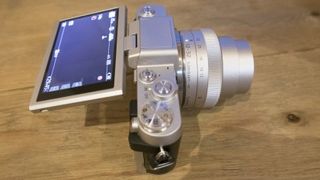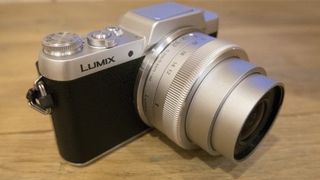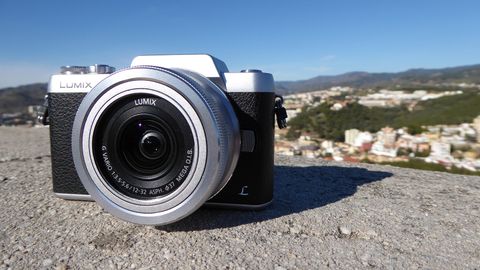TechRadar Verdict
Familiar fantastic Panasonic image quality in a fun, light and easy-to use body with a tilting touchscreen and Wi-Fi.
Pros
- +
Small body
- +
Touch sensitive screen
- +
Wi-Fi connectivity
Cons
- -
No viewfinder or hotshoe
Why you can trust TechRadar
Panasonic's GF series compact system cameras are aimed at novice photographers, but since the introduction of the super-small Panasonic GM series, the GF range has taken a bit of a back seat.
But now Panasonic has refreshed the GF series with the GF7, which the company says is replacing the GF6 (although the older model will continue to be on sale for a short while).
Sensor specs
The GF7 uses the same Micro Four Thirds format sensor format as all of Panasonic's compact system cameras (and Olympus's). The pixel count of the GF7 remains the same as the GF6 at 16 million pixels, but the sensor itself is upgraded to the model used in a camera much further up the Panasonic range, the GX7.
The processing engine is the same as the GX7's, too. This allows a data readout of 240fps (frames per second), which should be good news for the autofocus speed. The AF point can be set to any point across the imaging frame and there's both Face and Eye detection AF mode.
Panasonic claims that the AF system can operate in very low light, down to -4EV, but Focus Peaking is on hand for those occasions when you need to focus manually. It's also possible to shoot at up to 5fps in continuous autofocus mode, or 5.8fps in single AF mode when the focus is set at the start of the sequence.
Selfie screen
Like the GF6, the GF7 has a screen which can be flipped upwards through 180 degrees, and when you do this the camera automatically switches to Selfie mode. In Face Shutter mode, the wave of a hand in front of a face will trigger the shutter, while Buddy Shutter mode is designed to help when taking selfies with friends.


There's also a Jump Snap mode which uses the GF7's built in wi-fi – you put the camera on a tripod, connect the camera to a smartphone and put the phone in your pocket. The phone detects when you're in mid-jump and trips the camera's shutter release.
Panasonic says that it is easier to make a Wi-Fi connection with the GF7, as after the first connection has been made, pressing the Wi-Fi button makes a reconnection. There's also a direct picture upload option for easier image sharing.
Other camera features include a sensitivity range of ISO 200 - 25600, a maximum shutter speed of 1/16000 of a second and a more compact and lightweight body than its predecessor. As well as shooting full HD movies, the GF7 can create time lapses and stop motion animations, and has a Snap Movie mode which creates 2, 4, 6 or 8 seconds of video.
Kit lens
Whereas the GF6 came supplied with a fairly large 14-42mm kit lens, compared to the size of the body, the GF7 will ship with the smaller, collapsible 12-32mm kit lens. This is the lens that Panasonic has previously packaged with its super-compact GM range.

Although this does mean you lose some focal range, it makes the overall size of the camera much more pocket friendly. There are a huge range of compatible lenses for the Micro Four Thirds system, and the GF7's lens mount is compatible not only with Panasonic optics, but also those produced by Olympus and Micro Four Thirds lenses from third party manufacturers such as Sigma.
There's a fair amount of competition in this sector of the market, but perhaps the closest rivals are Panasonic's own GM5, the Sony A5100 and the Olympus PEN E-PL7.
Amy has been writing about cameras, photography and associated tech since 2009. Amy was once part of the photography testing team for Future Publishing working across TechRadar, Digital Camera, PhotoPlus, N Photo and Photography Week. For her photography, she has won awards and has been exhibited. She often partakes in unusual projects - including one intense year where she used a different camera every single day. Amy is currently the Features Editor at Amateur Photographer magazine, and in her increasingly little spare time works across a number of high-profile publications including Wired, Stuff, Digital Camera World, Expert Reviews, and just a little off-tangent, PetsRadar.


